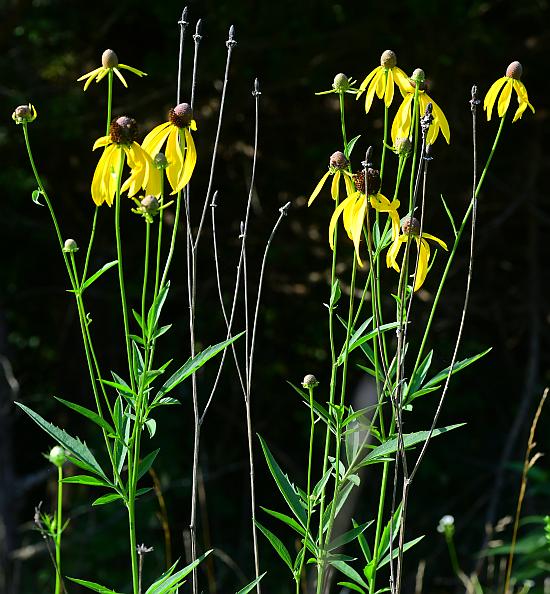Ratibida pinnata (Vent.) Barnhart
Gray-headed Coneflower

Native
CC = 4
CW = 5
MOC = 77
© SRTurner
Ratibida pinnata (Vent.) BarnhartGray-headed Coneflower | |
 |
Native CC = 4 CW = 5 MOC = 77 |
© SRTurner |
|
Family - Asteraceae/Heliantheae Habit - Perennial forb with a stout, horizontal rootstock (often a short rhizome) and fibrous roots. Stems - Ascending to erect, to 1.5 m, solitary or few to several, sometimes appearing clustered, sometimes branched, ridged, moderately to densely pubescent with short, stiff, antrorse hairs, sometimes nearly glabrous toward the base, also with scattered, minute, sessile, spherical, yellow glands.
Leaves - Alternate, deeply divided or compound, petiolate to sessile. Blades 4-40 cm long, mostly broadly oblong-ovate to oblong-obovate or oblong-elliptic in outline, those of the undivided leaves usually lanceolate, 1 time deeply pinnately divided or compound, those of the uppermost leaves sometimes undivided, the divisions or leaflets 3-9, 1-15 cm long, entire or deeply toothed or pinnately lobed, narrowly lanceolate to ovate, with 1 or 3 main veins, the surfaces moderately to densely pubescent with short, stiff, appressed to more or less spreading, sometimes pustular-based hairs, usually also dotted with scattered, minute, sessile to impressed glands.
Inflorescences - Solitary terminal heads positioned mostly well above the leaves, the stalks to 30 cm long. Heads - Radiate. Involucral bracts 10-15, hairy, those of the outer series 3-15 mm long, linear, those of the inner series 3-6 mm long, mostly narrowly ovate. Receptacle strongly convex to nearly spherical, 1.0-2.5 cm long, with chaffy bracts subtending and partially cloaking the disk florets.
Flowers - Ray florets 6-15, sterile, the corolla 30-60 mm long, yellow, drooping, the outer surface usually densely but inconspicuously short-hairy, the inner surface often sparsely hairy toward the base, both surfaces usually with scattered, minute, sessile, spherical, yellow glands. Disc florets numerous, perfect, the corolla 2-4 mm long, greenish yellow to yellowish green, sometimes purplish-tinged toward the tip. Style branches with the sterile tip slender and sharply pointed. Pappus absent.
Fruits - Achenes 2-4 mm long, slightly obliquely oblong, the angle opposite the chaffy bract sometimes sparsely hairy or with a narrow, lighter-colored wing. Flowering - May - September. Habitat - Prairies, glades, savannas, openings of upland forests, fencerows, pastures, railroads, roadsides. Origin - Native to the U.S. Lookalikes - None close. Other info. - This plant is common in the state and easy to ID in the field. The egg-shaped disk, drooping yellow rays, and pinnate leaves are good characteristics to look for. The plant's range is within the U.S. Midwest. It is hardy and showy, and makes a good garden subject. The dried flower heads, when crushed, emit a pleasant fragrance. Plant photographs taken off Hwy H., Shannon County, MO., 7-3-03 and 6-25-04 (DETenaglia); also at Shaw Nature Reserve, Franklin County, MO, 7-2-2007, and Little Lost Creek Conservation Area, Warren County, MO, 7-7-2020 (SRTurner). |